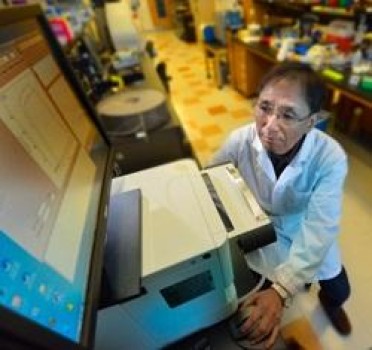
“The power plants that fuel liver cells rapidly splinter when exposed to bile salts that aid digestion, prompting cell death, but blocking this excessive fission appears to protect the liver, scientists report.
Hepatitis, steroids, birth control pills, alcohol, cancer, even gallstones can interfere with bile secretion, causing the fluid, which is made by the liver to help digest food, to stay in the liver, where it’s toxic to cells, said Dr. Yisang Yoon, cell physiologist at the Medical College of Georgia at Georgia Regents University.
It’s called cholestasis, a sometimes tough-to-treat condition that can damage or destroy the liver.
A study in The Journal of Biological Chemistry links the unusual shape of the cell powerhouses, or mitochondria, that occurs in cholestasis to their rapid fragmentation from exposure to the bile salt glycochenodeoxycholate. Also, in both cell culture and a mouse model of the condition, blocking the excessive splintering reduced production of reactive oxygen species, a potentially harmful byproduct of metabolism, as well as cell death.
The findings point toward novel cholestasis therapies that stop the excessive division that leaves powerhouses in dysfunctional tatters.
In a sort of continuous biological circle, the liver uses cholesterol to make bile, which the gastrointestinal tract uses to break down fats. As it’s made, bile passes from the liver to the gallbladder for storage until needed. When, gallstones, for example, push bile back where it came from, it can be lethal.
“Basically it destroys the cell,” said Yoon, the study’s corresponding author, who wanted to understand the role of mitochondria and what might be done to intervene.
Fission, as well as fusion — when different parts come together — is normal for mitochondria, which frequently change form. While the why isn’t completely understood, scientists such as Yoon believe the splintering and melding is to enhance efficiency. Older mitochondria may fuse to younger ones to maintain their powerhouse function. Or a mitochondrion may split to get rid of a dysfunctional section. Generation of ROS, a byproduct of the energy production and use, is normal as well, but, as with fission, too much is bad for the cell.
The MCG scientist found increases in ROS levels coincide with the level of mitochondrial fragmentation, suggesting a close relationship between the two. In fact, bile directly increases the mitochondria’s production of ROS. More of both support cell suicide as now sick or injured cells signal mitochondria to release factors such as cytochrome c into the cell cytoplasm. Outside the mitochondria cytochrome c, which normally helps make energy, is cell deadly.
Yoon and his research team found that glycochenodeoxycholate is a primary instigator of the rapid and sustained mitochondrial fragmentation that occurs in cholestasis and that when they blocked the excessive fission, ROS production, liver injury and scarring, which can lead to cirrhosis and loss of liver function, were all substantially diminished. “It looks like inhibiting fission would be one way to decrease these bad outcomes,” Yoon said.
For the studies, they reduced fission by making a mutant of DLP1, the main protein that mediates it. Yoon is currently searching for small peptides that bind to DLP1 in the search for a targeted therapy that might also work in humans. He notes that, at least in their animal model, liver cell function appeared normal after blocking the function of DLP1.
Cholestasis also results in high bile levels in the blood. Current therapies include surgery or endoscopic approaches to remove obstruction to bile secretions such as gallstones or scar tissue and/or removing contributing drugs or toxins. The most serious cases cause liver failure, which requires a liver transplant.
Story Source:
The above story is based on materials provided by Medical College of Georgia at Georgia Regents University. Note: Materials may be edited for content and length.
Journal Reference:
- T. Yu, L. Wang, H. Lee, D. K. O’Brien, S. F. Bronk, G. J. Gores, Y. Yoon. Decreasing Mitochondrial Fission Prevents Cholestatic Liver Injury. Journal of Biological Chemistry, 2014; 289 (49): 34074 DOI: 10.1074/jbc.M114.588616
